You’ll discover that Ficus plants offer some of the most adaptable and striking indoor greenery options available today. From the classic Weeping Fig with its glossy leaves to the dramatic Fiddle Leaf Fig standing 6 feet tall, these versatile plants can transform any room into a natural sanctuary. While they’re known for their forgiving nature, each variety brings its own unique care requirements and growth patterns to the table.
Contents
- 1 1. Weeping Fig (Ficus Benjamina)
- 2 2. Fiddle Leaf Fig
- 3 3. Rubber Plant (Ficus Elastica)
- 4 4. Creeping Fig Ficus Pumila
- 5 5. Indian Banyan Tree
- 6 6. Ficus Lyrata Bambino
- 7 8. Burgundy Ficus
- 8 9. Ficus Ginseng Bonsai
- 9 10. Starlight Ficus Bushy Variety
- 10 11. Oak Leaf Fig Tree
- 11 12. Green Island Ficus
- 12 13. Moreton Bay Fig Tree
- 13 14. Chinese Banyan
- 14 15. Ficus Triangularis
1. Weeping Fig (Ficus Benjamina)
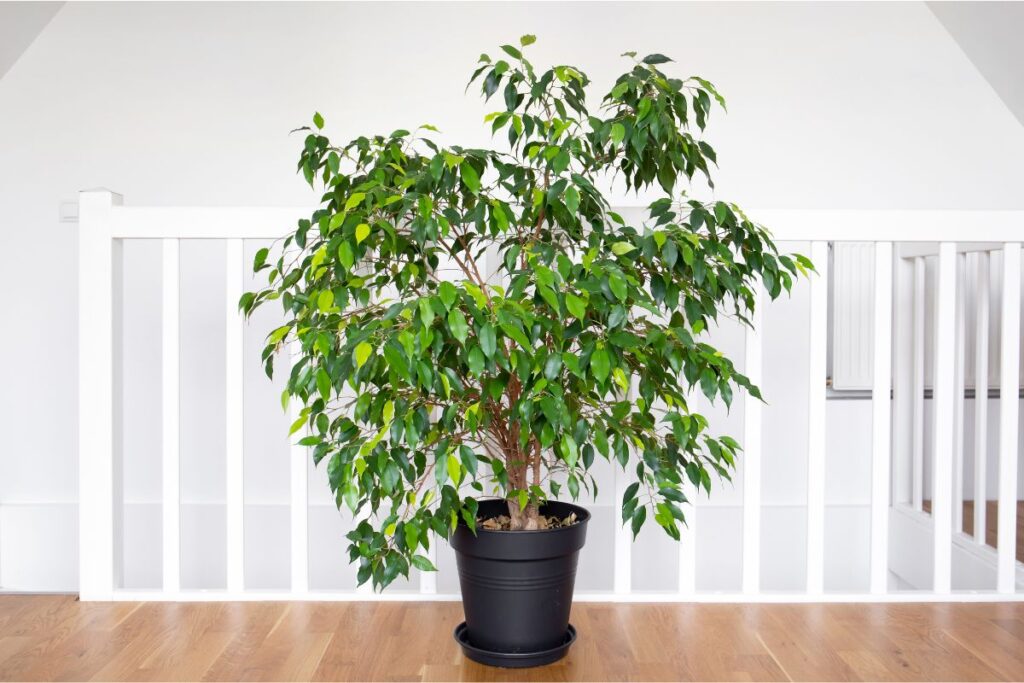
The Weeping Fig is one of the most popular indoor ficus varieties, known for its graceful drooping branches and dense, glossy foliage. This elegant tree can grow up to 60 feet tall in its natural habitat but stays manageable as a houseplant, typically reaching 6-8 feet indoors. Its small, oval-shaped leaves are dark green and slightly leathery, though variegated cultivars are also available. While beautiful, Ficus benjamina is notorious for dropping leaves when stressed or exposed to environmental changes, requiring consistent conditions to thrive.
- Light: Bright, indirect light; can tolerate some direct morning sun; avoid harsh afternoon sunlight
- Water: Keep soil consistently moist but not waterlogged; allow top inch of soil to dry between waterings
- Soil: Well-draining, rich potting mix with good aeration
- Humidity: Prefers moderate to high humidity; mist regularly or use a humidity tray
- Temperature: 65-75°F (18-24°C); protect from cold drafts
- Fertilizer: Feed monthly during growing season with balanced, water-soluble fertilizer
- Soil pH: 6.0-6.5
- Container: Choose pot with adequate drainage holes
2. Fiddle Leaf Fig
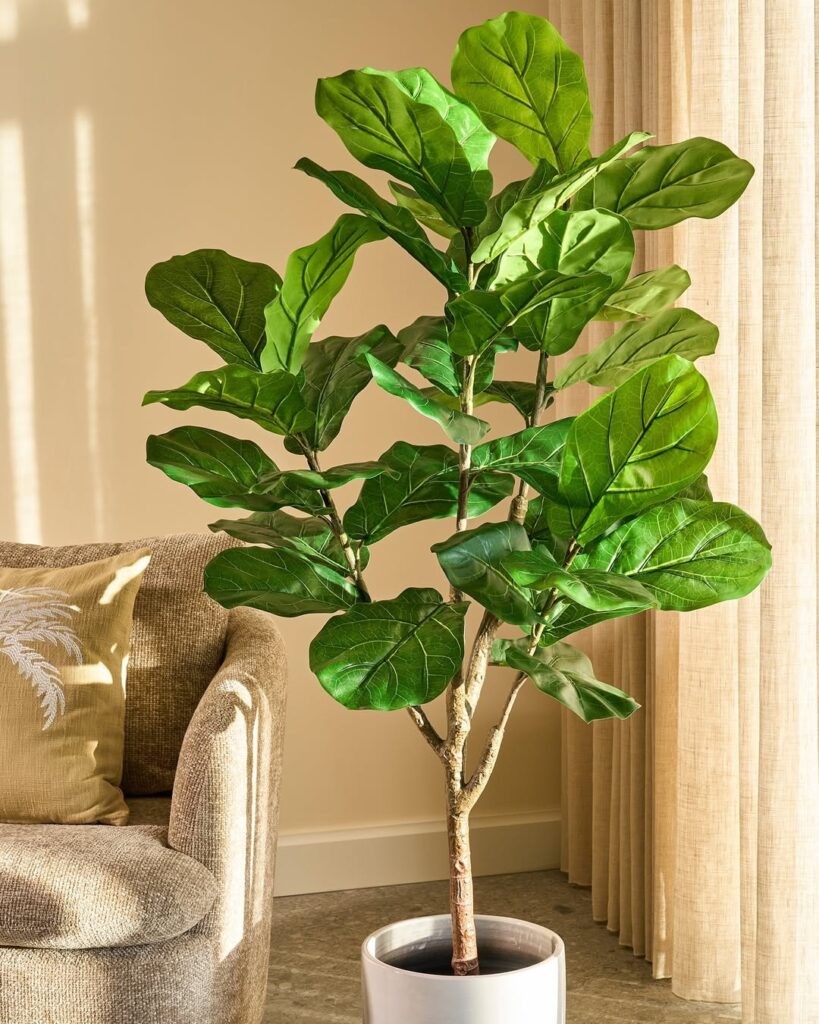
The Fiddle Leaf Fig (Ficus lyrata) is a striking indoor plant known for its large, violin-shaped leaves and impressive height potential of up to 10 feet when grown indoors. Native to western Africa’s tropical rainforests, this popular houseplant features dark green, leathery leaves that can grow up to 18 inches long and create a dramatic architectural statement in any room. While beautiful, the Fiddle Leaf Fig has earned a reputation for being somewhat finicky, requiring consistent care to maintain its health and appearance.
- Light: Bright, indirect sunlight; can tolerate some direct morning sun but protect from harsh afternoon rays
- Water: Allow top 1-2 inches of soil to dry between waterings; water less in winter
- Soil: Well-draining, rich potting mix with good aeration
- Humidity: Prefers 40-60% humidity; mist leaves or use a humidifier in dry conditions
- Temperature: 60-75°F (15-24°C); avoid cold drafts and sudden temperature changes
- Fertilizer: Feed monthly during growing season with balanced liquid fertilizer
- Soil pH: 6.0-7.0
- Container: Use a pot with drainage holes to prevent root rot
- Repotting: Every 2-3 years or when roots become crowded
3. Rubber Plant (Ficus Elastica)
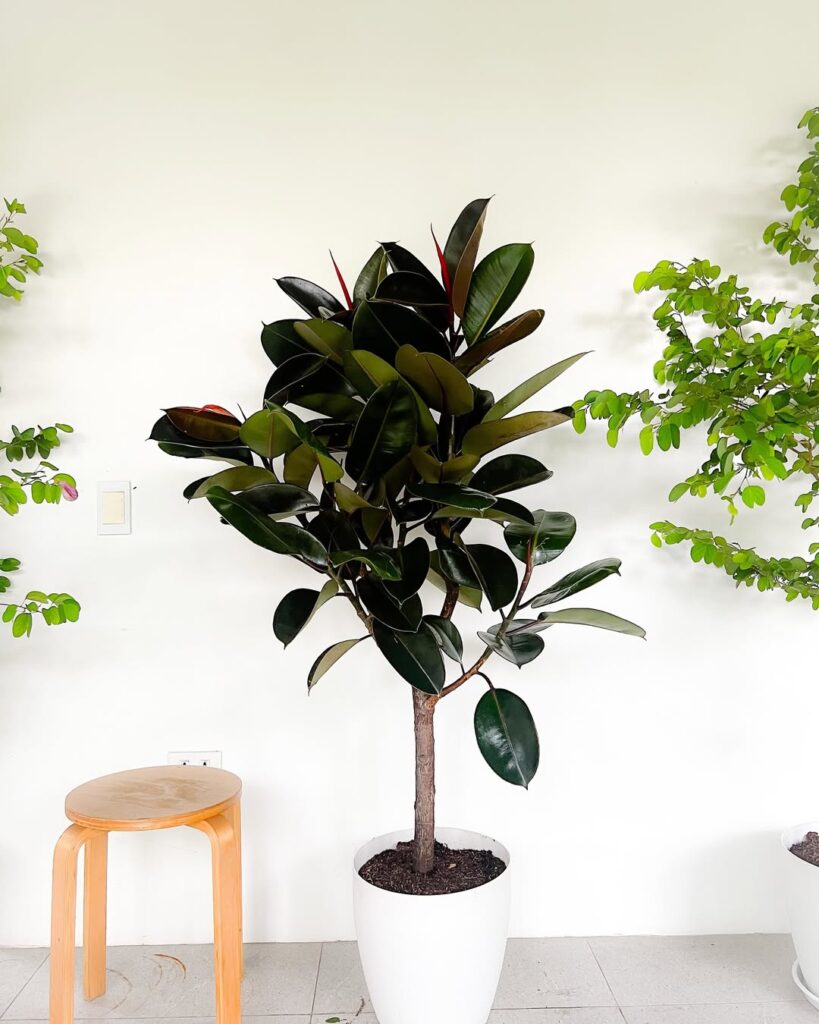
The Rubber Plant (Ficus elastica) is a striking indoor tree known for its thick, glossy leaves that can range from deep green to burgundy, depending on the variety. Native to Southeast Asia, this popular houseplant can grow up to 10 feet tall indoors and features oval-shaped leaves that can reach 12 inches in length. Its name comes from the white latex sap it produces, which was historically used in rubber production. The plant’s architectural form and low-maintenance nature make it an excellent choice for creating dramatic focal points in homes and offices.
- Light: Bright, indirect light; can tolerate moderate light but may drop leaves in low light conditions; protect from direct sunlight
- Water: Allow top 1-2 inches of soil to dry between waterings; reduce watering in winter
- Soil: Well-draining potting mix rich in organic matter
- Humidity: Moderate to high; benefits from regular misting
- Temperature: 60-80°F (15-27°C); avoid cold drafts
- Fertilizer: Feed monthly during growing season with balanced liquid fertilizer
- Soil pH: 6.0-7.0
- Repotting: Every 2-3 years or when roots become crowded
4. Creeping Fig Ficus Pumila
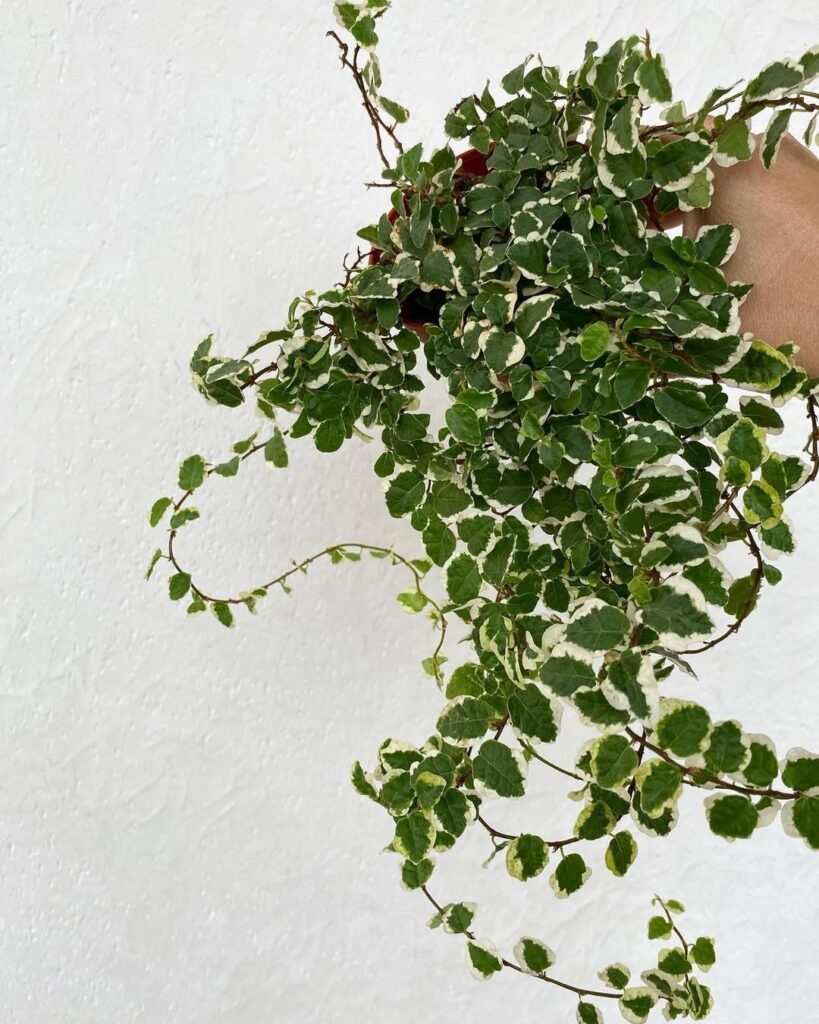
Creeping Fig (Ficus pumila) is a fast-growing, climbing vine with small, heart-shaped leaves that cling tightly to surfaces through aerial rootlets. This diminutive member of the fig family creates a dense mat of foliage and can be used as a wall covering, ground cover, or in hanging baskets. In its juvenile form, the leaves are small and delicate, while mature plants develop larger, more leathery foliage. When grown indoors, it typically maintains its smaller juvenile leaves and remains manageable with regular pruning.
- Light: Bright, indirect light; can tolerate moderate shade but avoid direct sunlight
- Water: Keep soil consistently moist but not waterlogged; water when top inch of soil feels dry
- Soil: Well-draining, rich potting mix with organic matter
- Humidity: Prefers high humidity; mist regularly or use a humidity tray
- Temperature: 65-75°F (18-24°C)
- Fertilizer: Feed monthly during growing season with balanced liquid fertilizer
- Growing Medium: Can climb walls, trellises, or moss poles; also suitable for hanging baskets
- Pruning: Trim regularly to control size and maintain desired shape
5. Indian Banyan Tree
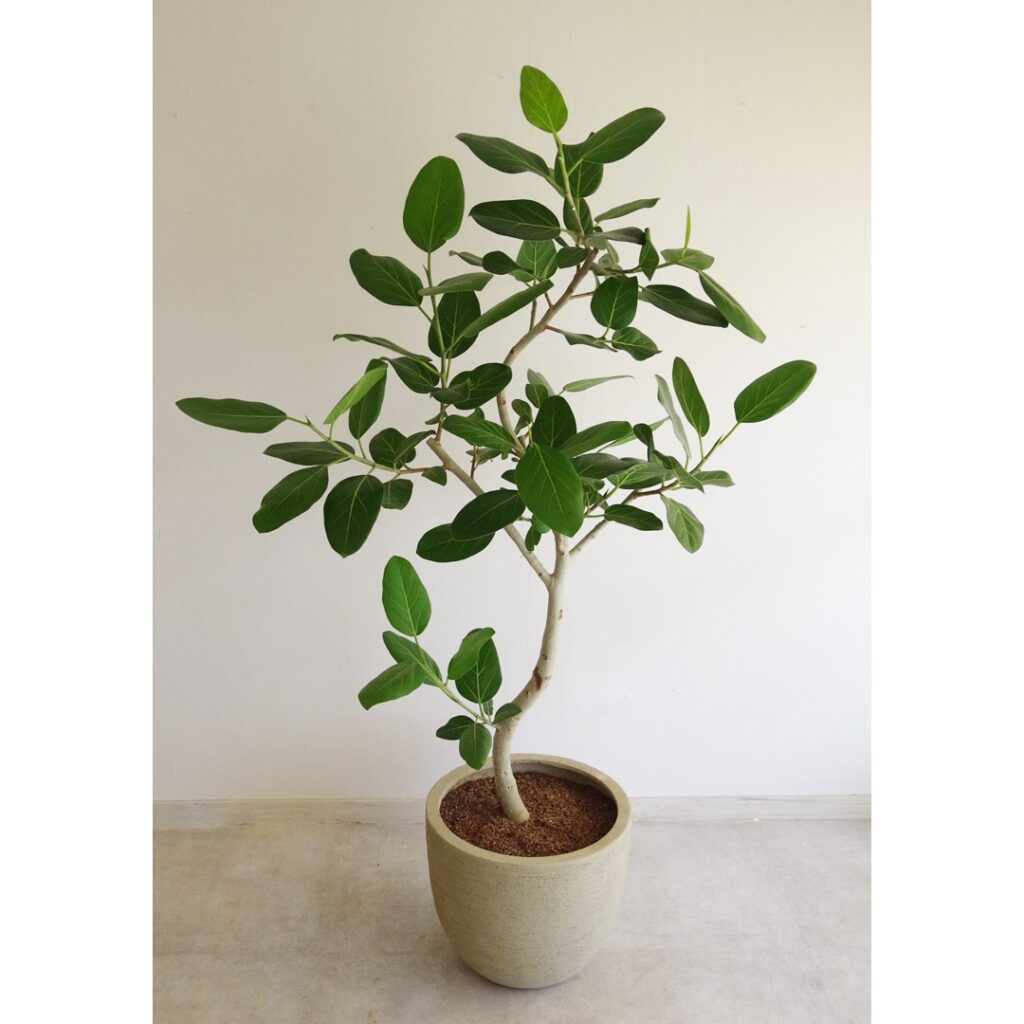
The Indian Banyan Tree (Ficus benghalensis) is a majestic fig species native to the Indian subcontinent that can grow into an enormous tree in its natural habitat, with aerial roots that develop into additional trunks. When grown indoors, it remains much smaller but still maintains its distinctive growth pattern and glossy, oval-shaped leaves. As a houseplant, it serves as an attractive ornamental specimen that can be pruned and maintained as a manageable indoor tree or bush.
- Light: Bright, indirect sunlight; can tolerate some direct morning sun but should be protected from harsh afternoon rays
- Water: Keep soil consistently moist but not waterlogged; water when top inch of soil feels dry
- Soil: Well-draining, rich potting mix with high organic content
- Humidity: Prefers moderate to high humidity; benefits from regular misting
- Temperature: 60-85°F (16-29°C); protect from cold drafts
- Fertilizer: Feed monthly during growing season with balanced liquid fertilizer
- Pot: Large container with adequate drainage holes to accommodate extensive root system
6. Ficus Lyrata Bambino

The Ficus Lyrata Bambino, also known as the Dwarf Fiddle Leaf Fig, is a compact version of the popular Fiddle Leaf Fig tree. This miniature variety typically grows to about 3-4 feet tall, making it perfect for smaller spaces while maintaining the same distinctive large, violin-shaped leaves as its larger cousin. The leaves are thick and glossy with prominent veining, growing in an upright pattern along the stem, creating an attractive architectural presence in any room.
- Light: Bright, indirect light; can tolerate some direct morning sun but protect from harsh afternoon rays
- Water: Allow top 1-2 inches of soil to dry between waterings; reduce watering in winter
- Soil: Well-draining, rich potting mix with good aeration
- Humidity: Moderate to high; benefits from regular misting or humidifier
- Temperature: 60-75°F (15-24°C); avoid cold drafts and sudden temperature changes
- Fertilizer: Feed monthly during growing season with balanced liquid fertilizer
- Pot: Choose container with drainage holes; repot every 2-3 years
- Growth Rate: Slow to moderate growth rate
8. Burgundy Ficus
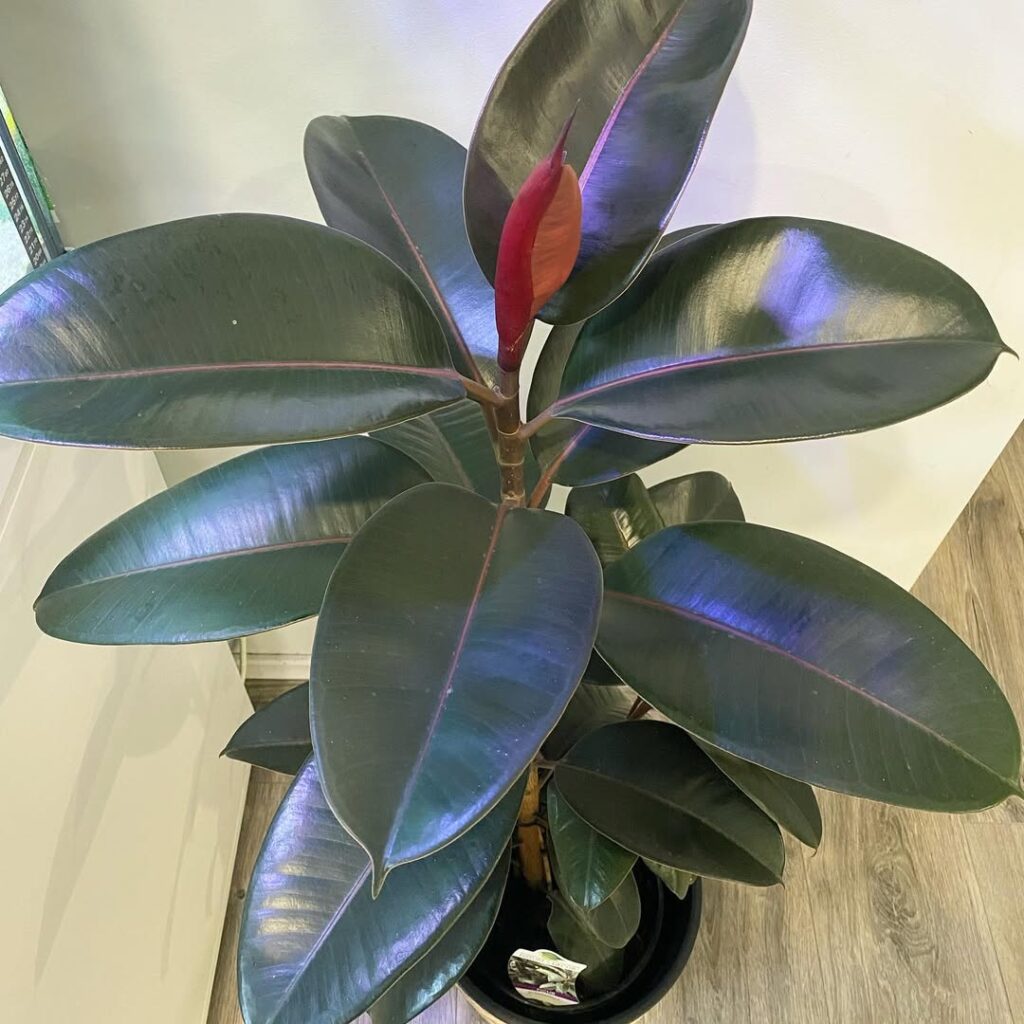
The Burgundy Ficus (Ficus elastica ‘Burgundy’) is a striking variety of rubber plant known for its large, glossy leaves in deep burgundy to purple-red hues. This dramatic indoor tree can grow up to 10 feet tall when grown indoors, featuring thick, leathery foliage that emerges from pink-colored sheaths. The leaves maintain their rich color throughout their lifespan, making this plant an attractive focal point in any room.
- Light: Bright, indirect light; can tolerate some direct morning sun; protect from intense afternoon sunlight
- Water: Allow top 1-2 inches of soil to dry between waterings; reduce watering in winter
- Soil: Well-draining potting mix rich in organic matter
- Humidity: Moderate to high; mist leaves regularly or use a humidity tray
- Temperature: 60-80°F (15-27°C); avoid cold drafts
- Fertilizer: Feed monthly during growing season with balanced liquid fertilizer
- Pruning: Remove damaged leaves and prune in spring to control size and shape
- Repotting: Every 2-3 years or when roots become pot-bound
9. Ficus Ginseng Bonsai
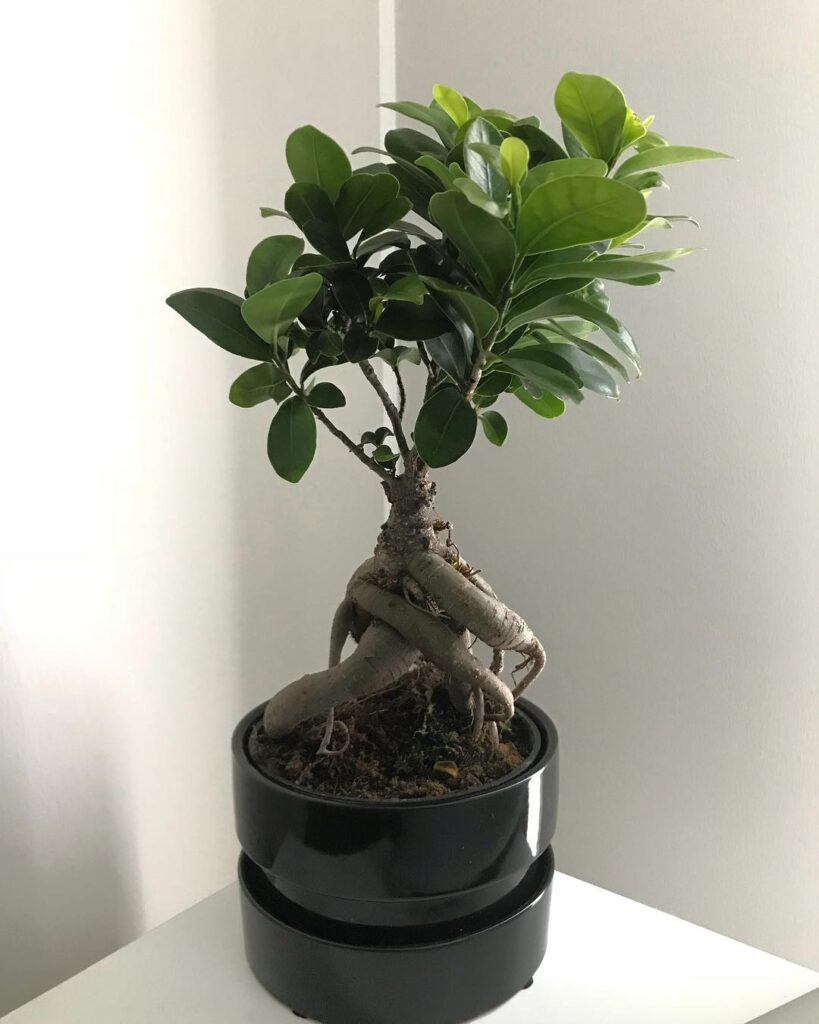
Ficus Ginseng Bonsai is a compact, ornamental variety of Ficus microcarpa featuring a distinctive thick, bulbous trunk reminiscent of ginseng roots. This eye-catching plant maintains a dwarf form with small, oval-shaped glossy leaves and an artistic, tree-like appearance that makes it a popular choice for indoor bonsai cultivation. While it’s styled as a traditional bonsai, it’s more forgiving and easier to maintain than many other bonsai species, making it suitable for beginners.
- Light: Bright, indirect sunlight; can tolerate some direct morning sun but avoid harsh afternoon light
- Water: Keep soil consistently moist but not waterlogged; water when top inch of soil feels dry
- Humidity: Prefers moderate to high humidity; benefits from regular misting
- Temperature: 65-75°F (18-24°C); protect from cold drafts
- Soil: Well-draining bonsai mix or a combination of potting soil with sand and perlite
- Fertilizer: Feed with balanced liquid fertilizer every 2-4 weeks during growing season
- Pruning: Regular trimming to maintain shape and size; prune new growth to 2-3 leaves
- Container: Shallow bonsai pot with adequate drainage holes
10. Starlight Ficus Bushy Variety
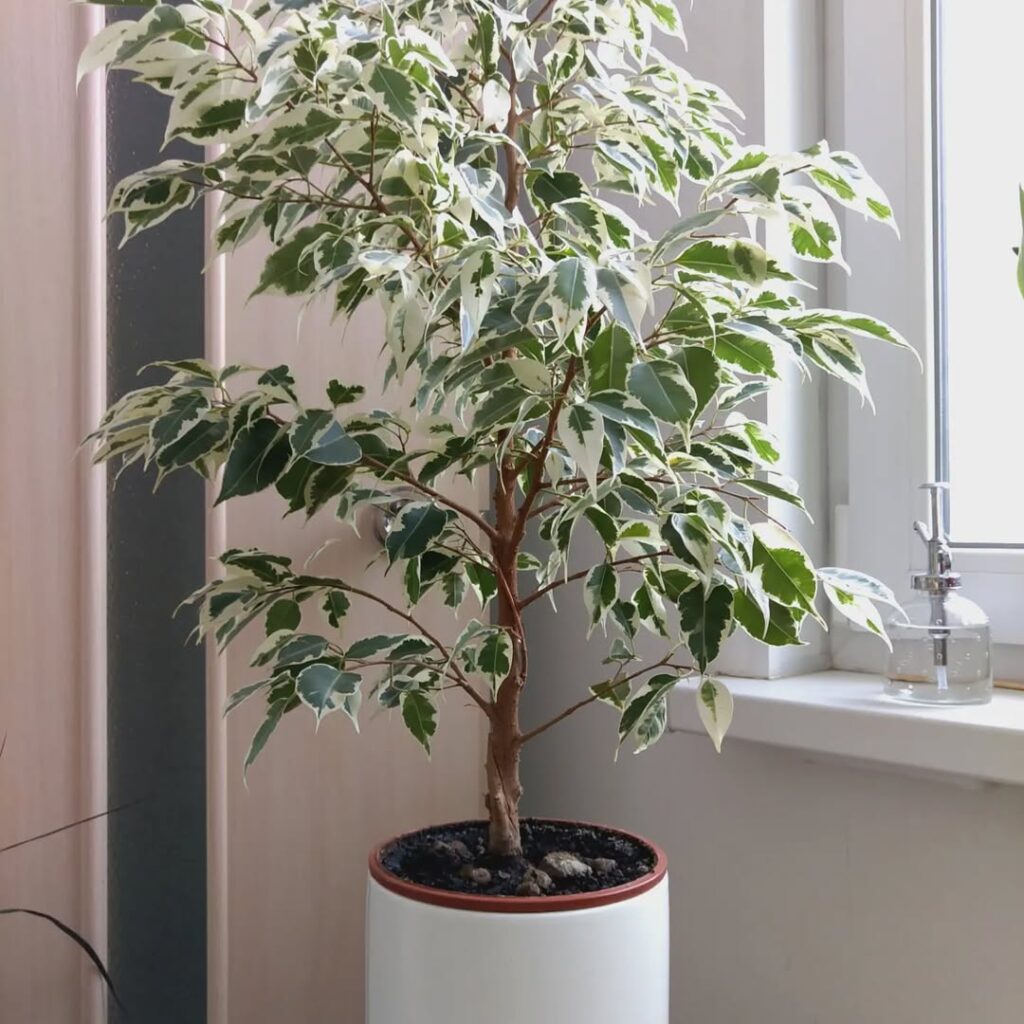
The Starlight Ficus is a compact, bushy variety of ficus that features variegated leaves with creamy white and green patterns. This decorative houseplant typically grows to 3-4 feet tall indoors and maintains a naturally full, rounded shape with dense foliage. Its smaller leaves and manageable size make it an excellent choice for indoor spaces where a standard ficus might become too large.
- Light: Bright, indirect sunlight; can tolerate moderate light but may lose variegation in low-light conditions
- Water: Keep soil consistently moist but not waterlogged; water when top inch of soil feels dry
- Soil: Well-draining, rich potting mix with added perlite
- Humidity: Prefers moderate to high humidity; mist regularly or use a humidity tray
- Temperature: 65-80°F (18-27°C); protect from cold drafts
- Fertilizer: Feed monthly during growing season with balanced, water-soluble fertilizer
- Pruning: Trim regularly to maintain bushy shape and control size
11. Oak Leaf Fig Tree
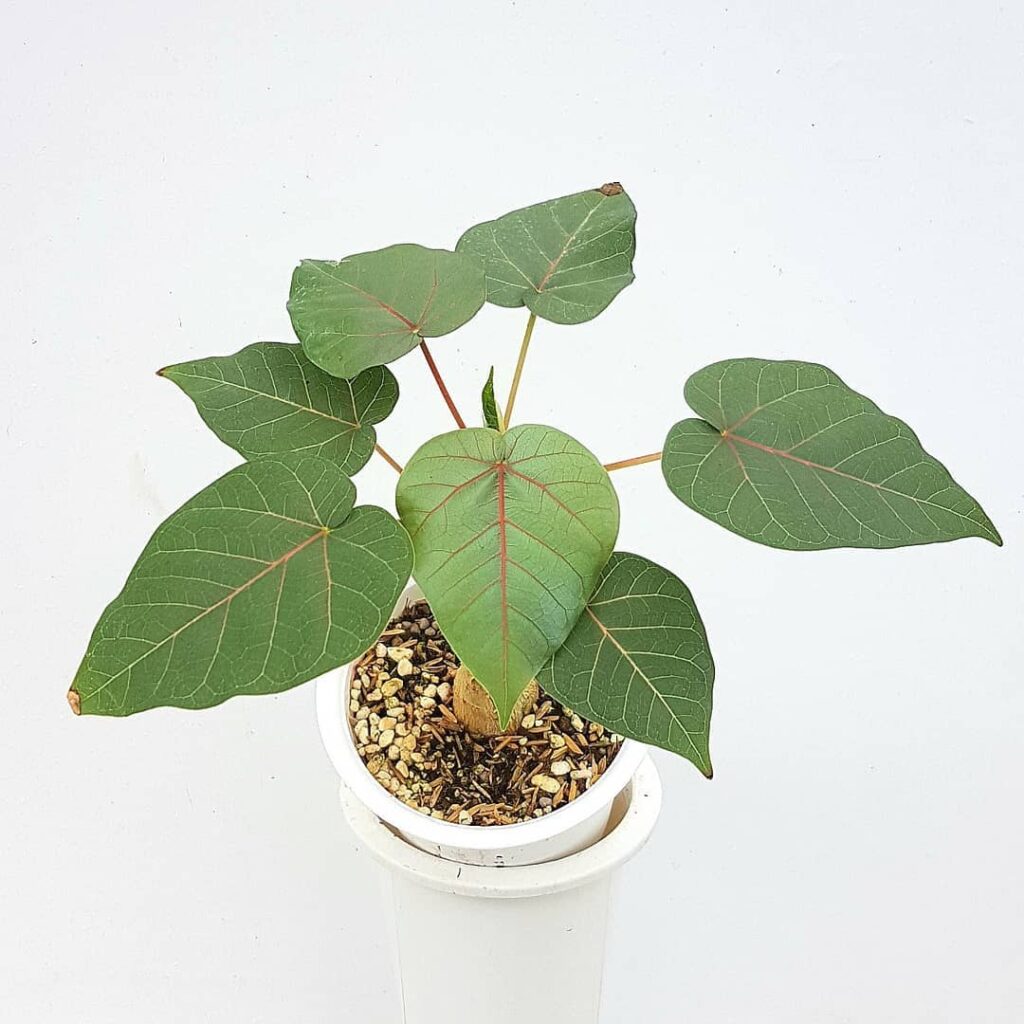
The Oak Leaf Fig (Ficus petiolaris) is a striking indoor tree known for its distinctive foliage that resembles oak leaves, setting it apart from other ficus varieties. This Mexican native develops thick, leathery leaves with wavy edges and can grow into a compact indoor tree reaching heights of 6-8 feet when grown in containers. Its leaves emerge with a bronze tint before maturing to a deep green color, and the plant produces a strong central trunk with an attractive branching pattern.
- Light: Bright, indirect sunlight; can tolerate some direct morning sun but protect from harsh afternoon rays
- Water: Allow top inch of soil to dry between waterings; reduce watering in winter
- Soil: Well-draining, fertile potting mix rich in organic matter
- Humidity: Moderate to high; benefits from regular misting
- Temperature: 65-80°F (18-27°C); protect from cold drafts
- Fertilizer: Feed monthly during growing season with balanced liquid fertilizer
- Pruning: Light pruning in spring to maintain shape and remove dead foliage
- Repotting: Every 2-3 years or when roots become crowded
12. Green Island Ficus
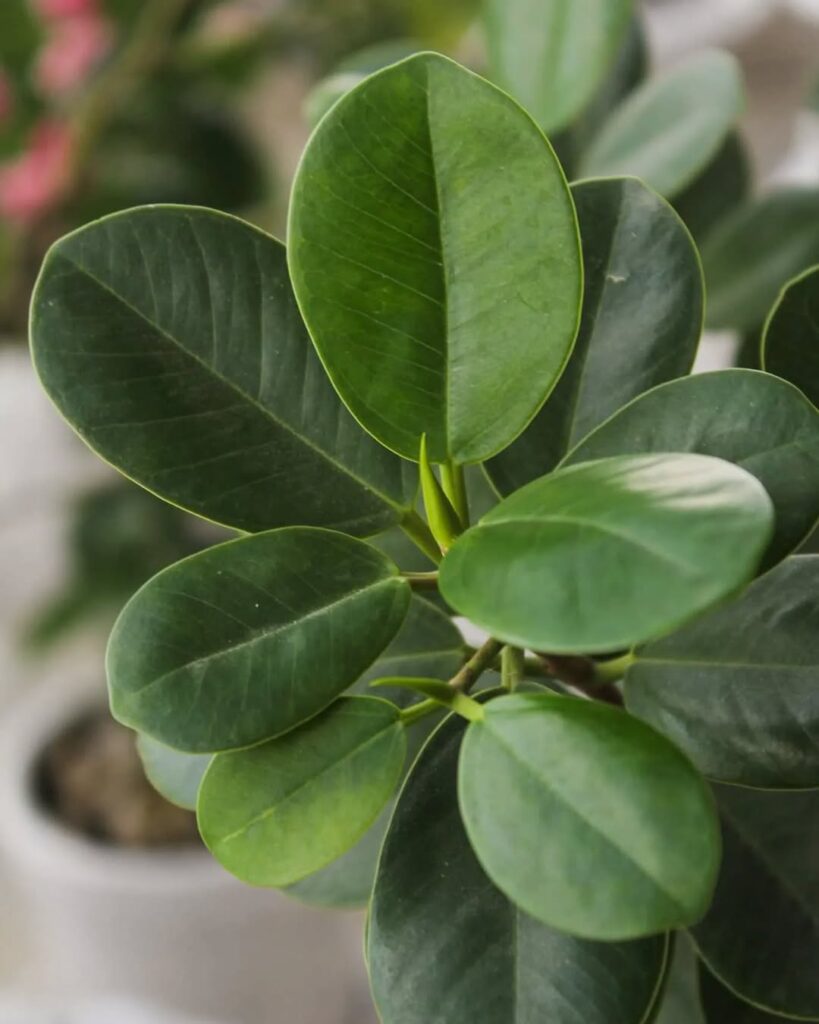
The Green Island Ficus (Ficus microcarpa ‘Green Island’) is a compact, slow-growing variety that makes an excellent indoor plant. Its dense, rounded growth habit features small, oval-shaped leaves that are thick and leathery with a glossy dark green appearance. This dwarf cultivar typically reaches heights of 2-3 feet indoors, making it perfect for tabletops, shelves, or as a low-maintenance bonsai specimen.
- Light: Bright, indirect light; can tolerate moderate light conditions; avoid direct sunlight which can scorch leaves
- Water: Allow top inch of soil to dry between waterings; reduce watering in winter
- Soil: Well-draining potting mix with added perlite or bark
- Humidity: Moderate to high; benefits from regular misting or humidity tray
- Temperature: 65-85°F (18-29°C); protect from cold drafts
- Fertilizer: Feed monthly during growing season with balanced houseplant fertilizer
- Soil pH: 6.0-6.5
13. Moreton Bay Fig Tree
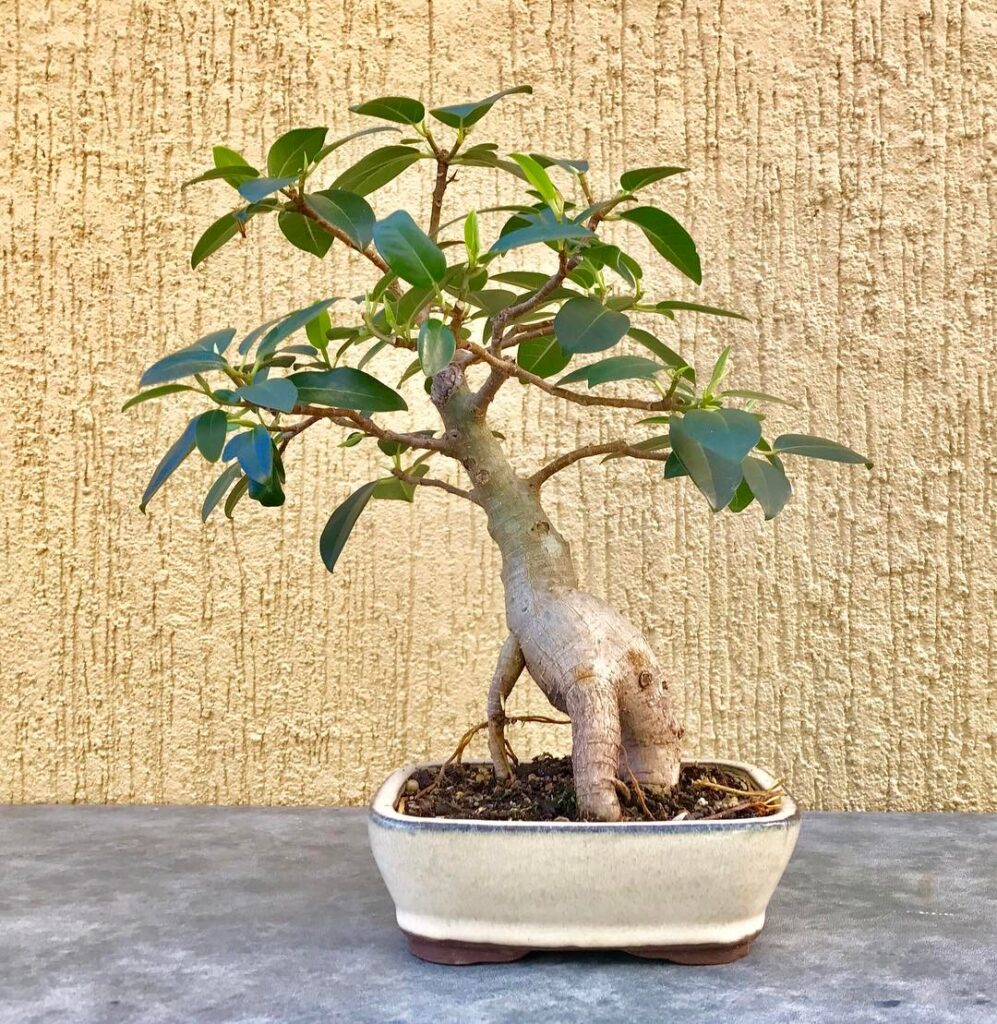
The Moreton Bay Fig Tree (Ficus macrophylla) is a majestic ficus species native to eastern Australia that can be grown as a striking indoor specimen. While it reaches massive heights of up to 200 feet in its natural habitat, when grown indoors it can be maintained at a more manageable size through regular pruning. This ficus variety features large, glossy, dark green leaves and develops a distinctive buttressed trunk system as it matures. Like other ficus species, it produces aerial roots that can become thick and woody over time, adding to its architectural appeal.
- Light: Bright, indirect light; can tolerate some direct morning sun but avoid harsh afternoon sunlight
- Water: Keep soil consistently moist but not waterlogged; water when top 1-2 inches of soil feels dry
- Soil: Well-draining, rich potting mix with organic matter
- Humidity: Moderate to high; benefits from regular misting
- Temperature: 60-75°F (15-24°C); protect from cold drafts
- Fertilizer: Feed monthly during growing season with balanced liquid fertilizer
- Container: Large pot with adequate drainage holes to accommodate extensive root system
- Pruning: Regular pruning needed to control size and maintain shape
14. Chinese Banyan
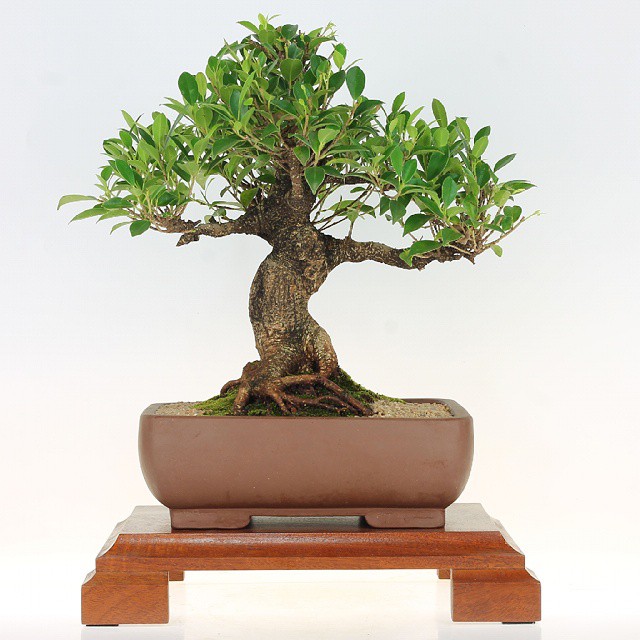
The Chinese Banyan (Ficus retusa) is a striking indoor tree known for its glossy oval leaves and elegant aerial roots that cascade from its branches. This versatile ficus species can be grown as a compact bonsai or allowed to reach heights of 6-8 feet indoors, making it suitable for various spaces. Its thick trunk and dense canopy create an attractive focal point, while its hardy nature makes it more forgiving than other ficus varieties when faced with occasional neglect or environmental changes.
- Light: Bright indirect light; can tolerate some direct morning sun but protect from harsh afternoon rays; maintain consistent light levels to prevent leaf drop
- Water: Allow top inch of soil to dry between waterings; reduce watering in winter; maintain moderate humidity through misting or humidity tray
- Soil: Well-draining potting mix rich in organic matter; pH between 6.0-6.5
- Temperature: 65-85°F (18-29°C); protect from cold drafts and sudden temperature changes
- Fertilizer: Feed monthly during growing season with balanced liquid fertilizer; reduce to quarterly in winter
- Pruning: Trim regularly to maintain desired shape and size; remove dead or yellowing leaves as needed
15. Ficus Triangularis
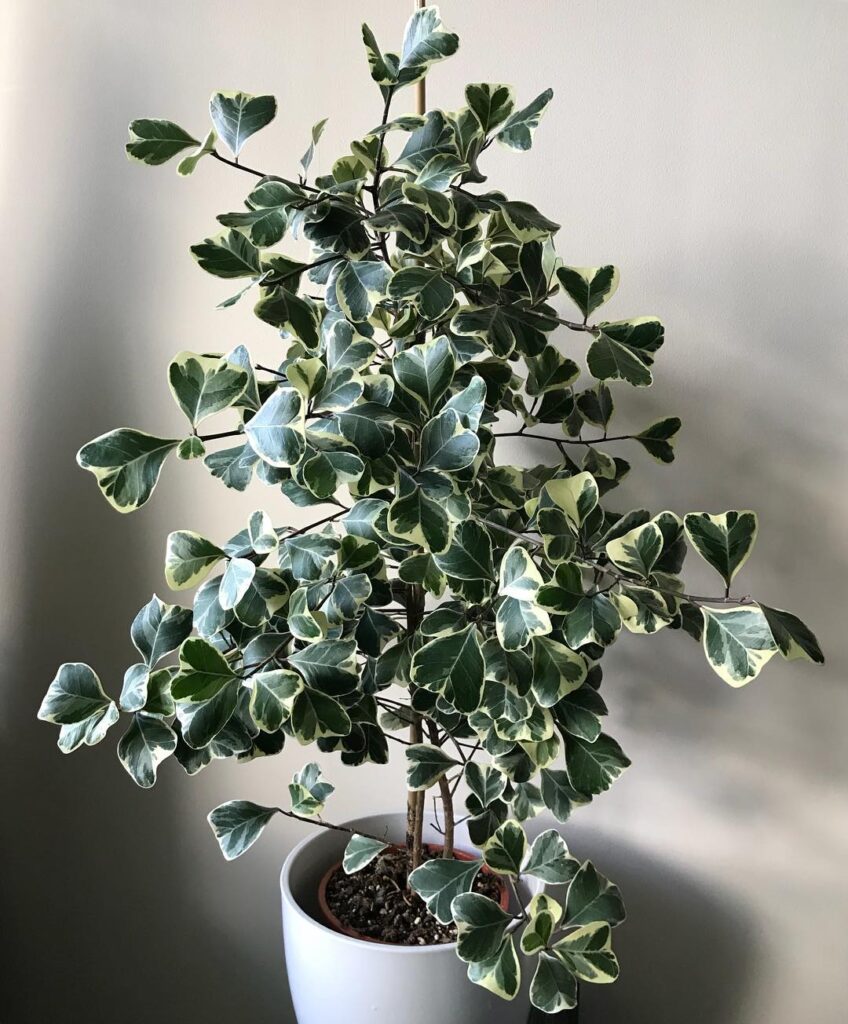
The Ficus Triangularis is a unique variety of ficus known for its small, triangular-shaped leaves that grow densely along thin branches, creating an attractive cascading effect. Native to South Africa, this compact evergreen can reach heights of 6-8 feet indoors and features dark green foliage with a leathery texture. Its manageable size and distinctive leaf shape make it an appealing choice for indoor spaces, whether grown as a small tree or maintained as a bush.
- Light: Bright, indirect light; can tolerate some direct morning sun but avoid harsh afternoon sun
- Water: Allow top inch of soil to dry between waterings; reduce watering in winter
- Soil: Well-draining potting mix rich in organic matter
- Humidity: Moderate to high humidity (40-60%)
- Temperature: 65-85°F (18-29°C); avoid cold drafts
- Fertilizer: Monthly feeding during growing season with balanced liquid fertilizer
- Pruning: Regular trimming to maintain shape and promote bushier growth
